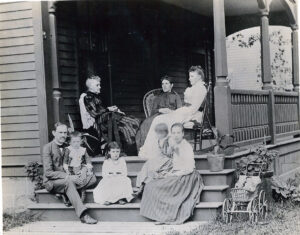By David Fleet
Editor
When Sterling Elliott saw a problem—he fixed it. From wagon springs to pivoting steering knuckles for vehicles to a pedal cycle the inventor changed  the way we drive today. Sterling Elliott was born in 1852 on a farm in Ortonville, his father operated the local flour mill, the farm work was turned over to Sterling when he was 12 years old and according to his biography his father discharged the hired farm hand at that time. Sterling also attended a local country school in the Ortonville area.
the way we drive today. Sterling Elliott was born in 1852 on a farm in Ortonville, his father operated the local flour mill, the farm work was turned over to Sterling when he was 12 years old and according to his biography his father discharged the hired farm hand at that time. Sterling also attended a local country school in the Ortonville area.
“It seems he wanted little to do with working on the farm,” said Linda Geary, curator of The Elliott Museum, Stuart, Fla. “In fixing problems he produced patents from the inventions and a few of those changed our lives today. In 1869 at the age of 17 Sterling walked the 92 miles from Ortonville to Grand Rapids with just $8 in his pocket. His mother helped him pack.”
Elliott then moved from Grand Rapids to Chicago and married at 18. At age 22 he landed the first of 125 United States patents, a spring that would keep buggies level when a passenger would climb aboard. A few years later one of Elliott’s greatest contributions was to the automobile industry when he was designing a four-wheeled pedal cycle for women.
Geary said the Museum was built in 1961 by Harmon Elliott as a tribute to his father, Sterling Elliott.
One of unique inventions, which received U.S. Patent No. 442,663 on Dec. 16, 1890 was Elliott’s Quadricycle (Velocipede).
According to reports, the quadricycle featured a non-turning front axle, the unequal turning of the front wheels, a differential rear axle, independent vertical action of all four wheels, and self-equalizing brakes. Prior to these inventions, farm wagons front wheels, via a pivoting axle turned as one. Elliott, recognized that to steer effectively and independently of a fixed front axle, the front wheels had to turn at different angles to be allowed to slip. Thus, Elliott created steering knuckles that would pivot, their angles controlled by a link narrower than the axle. Automobile companies paid big bucks for the steering system.
While the patent expired in 1907, several automobile companies paid big bucks for the idea.
“Sterling also designed a bicycle to make riding easier for women and supported a black racer when the League barred African Americans,” said Geary. “Years later that racer Marshall Taylor, was world champion. He moved to Massachusetts, in the late 1800s and built bicycles and was publisher of Bicycling World magazine. Among other inventions — a knot-tying machine to make magazine and book binding easier, he also built a addressing machine to ease the distribution of his and other magazines.” Elliott died in 1922.
